Business Analytics: Predicting Agricultural Loan Loss in Sri Lanka
VerifiedAdded on 2023/05/30
|63
|18533
|174
Project
AI Summary
This research project focuses on predicting the impact of environmental hazards on agricultural loan loss experience in large banks in Sri Lanka. The study begins with a comprehensive introduction, outlining the problem statement, research questions, and the background of Sri Lanka's agricultural sector and its reliance on agricultural loans from large banks. The project aims to identify the different factors contributing to agricultural loan loss, specifically focusing on environmental hazards. The methodology involves a literature review exploring agricultural loans, environmental factors, and risk management strategies, followed by a detailed discussion of the research methodology, including research philosophy, approach, design, data collection, and analysis methods. The project seeks to answer key research questions regarding the historical impact of environmental hazards, predictive modeling, and the development of innovative products for early identification of non-performing loans. The project will also provide recommendations for reducing the impact of environmental hazards on loan loss experience. The project includes a discussion of ethical considerations and references.
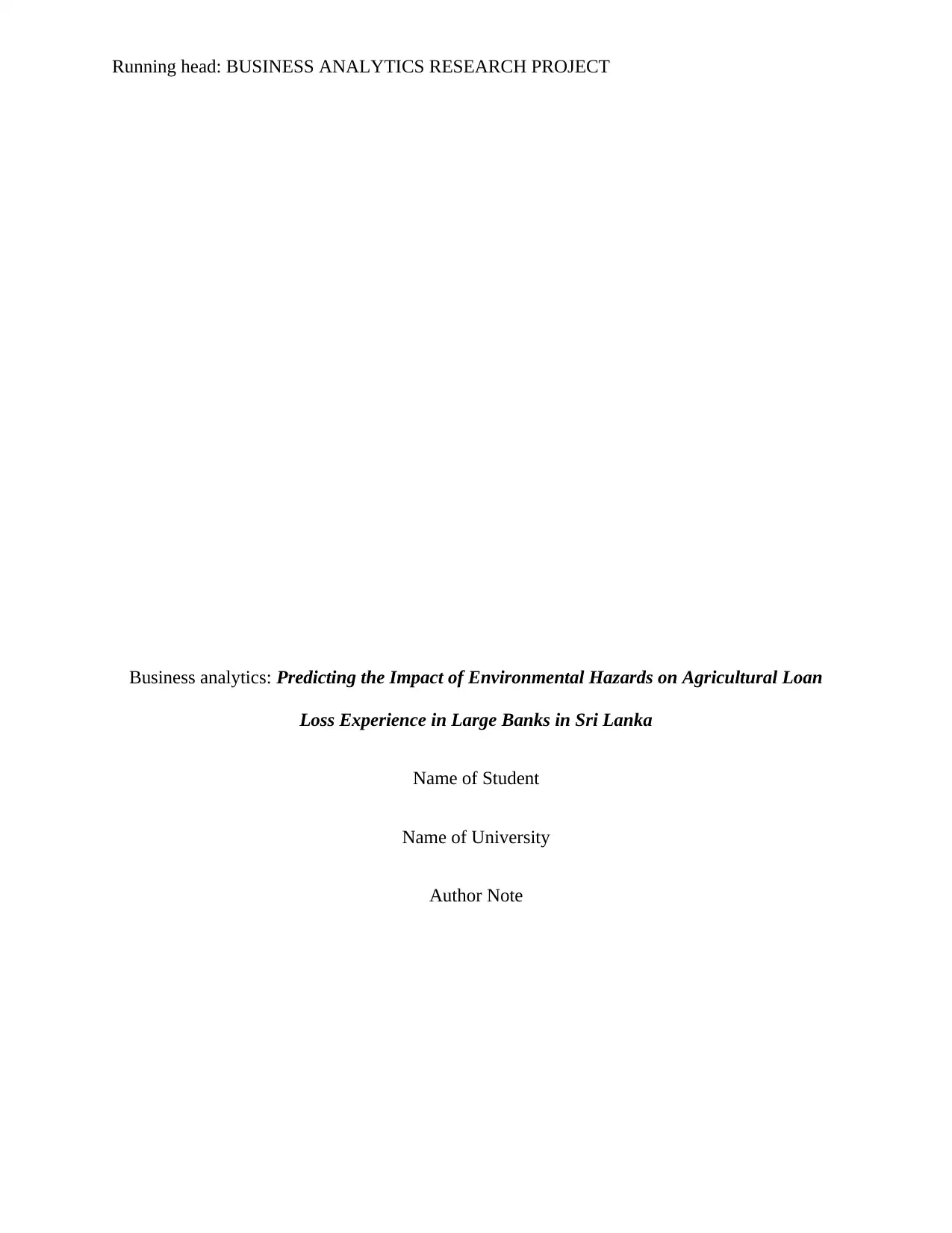
Running head: BUSINESS ANALYTICS RESEARCH PROJECT
Business analytics: Predicting the Impact of Environmental Hazards on Agricultural Loan
Loss Experience in Large Banks in Sri Lanka
Name of Student
Name of University
Author Note
Business analytics: Predicting the Impact of Environmental Hazards on Agricultural Loan
Loss Experience in Large Banks in Sri Lanka
Name of Student
Name of University
Author Note
Paraphrase This Document
Need a fresh take? Get an instant paraphrase of this document with our AI Paraphraser
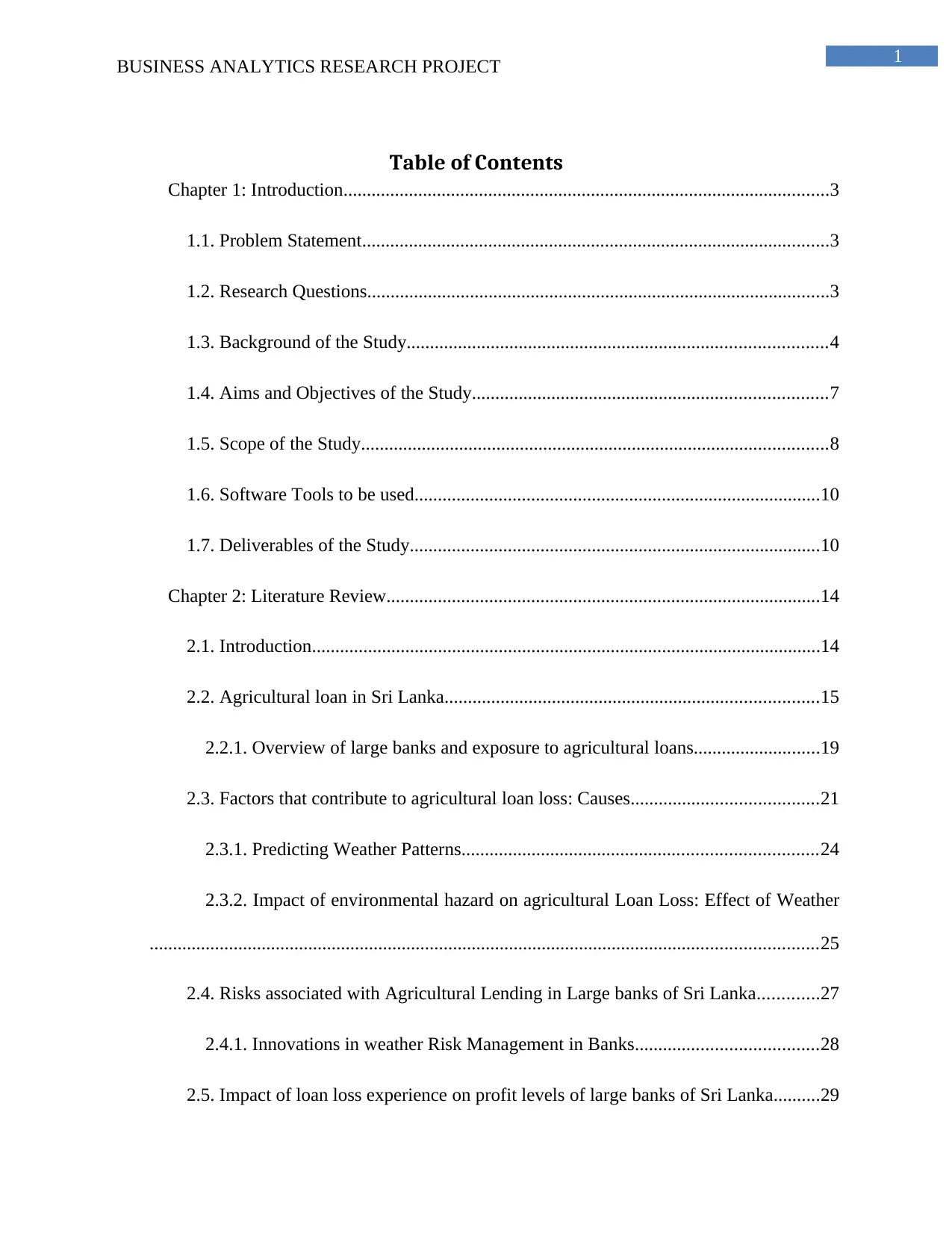
1
BUSINESS ANALYTICS RESEARCH PROJECT
Table of Contents
Chapter 1: Introduction........................................................................................................3
1.1. Problem Statement....................................................................................................3
1.2. Research Questions...................................................................................................3
1.3. Background of the Study..........................................................................................4
1.4. Aims and Objectives of the Study............................................................................7
1.5. Scope of the Study....................................................................................................8
1.6. Software Tools to be used.......................................................................................10
1.7. Deliverables of the Study........................................................................................10
Chapter 2: Literature Review.............................................................................................14
2.1. Introduction.............................................................................................................14
2.2. Agricultural loan in Sri Lanka................................................................................15
2.2.1. Overview of large banks and exposure to agricultural loans...........................19
2.3. Factors that contribute to agricultural loan loss: Causes........................................21
2.3.1. Predicting Weather Patterns............................................................................24
2.3.2. Impact of environmental hazard on agricultural Loan Loss: Effect of Weather
...............................................................................................................................................25
2.4. Risks associated with Agricultural Lending in Large banks of Sri Lanka.............27
2.4.1. Innovations in weather Risk Management in Banks.......................................28
2.5. Impact of loan loss experience on profit levels of large banks of Sri Lanka..........29
BUSINESS ANALYTICS RESEARCH PROJECT
Table of Contents
Chapter 1: Introduction........................................................................................................3
1.1. Problem Statement....................................................................................................3
1.2. Research Questions...................................................................................................3
1.3. Background of the Study..........................................................................................4
1.4. Aims and Objectives of the Study............................................................................7
1.5. Scope of the Study....................................................................................................8
1.6. Software Tools to be used.......................................................................................10
1.7. Deliverables of the Study........................................................................................10
Chapter 2: Literature Review.............................................................................................14
2.1. Introduction.............................................................................................................14
2.2. Agricultural loan in Sri Lanka................................................................................15
2.2.1. Overview of large banks and exposure to agricultural loans...........................19
2.3. Factors that contribute to agricultural loan loss: Causes........................................21
2.3.1. Predicting Weather Patterns............................................................................24
2.3.2. Impact of environmental hazard on agricultural Loan Loss: Effect of Weather
...............................................................................................................................................25
2.4. Risks associated with Agricultural Lending in Large banks of Sri Lanka.............27
2.4.1. Innovations in weather Risk Management in Banks.......................................28
2.5. Impact of loan loss experience on profit levels of large banks of Sri Lanka..........29
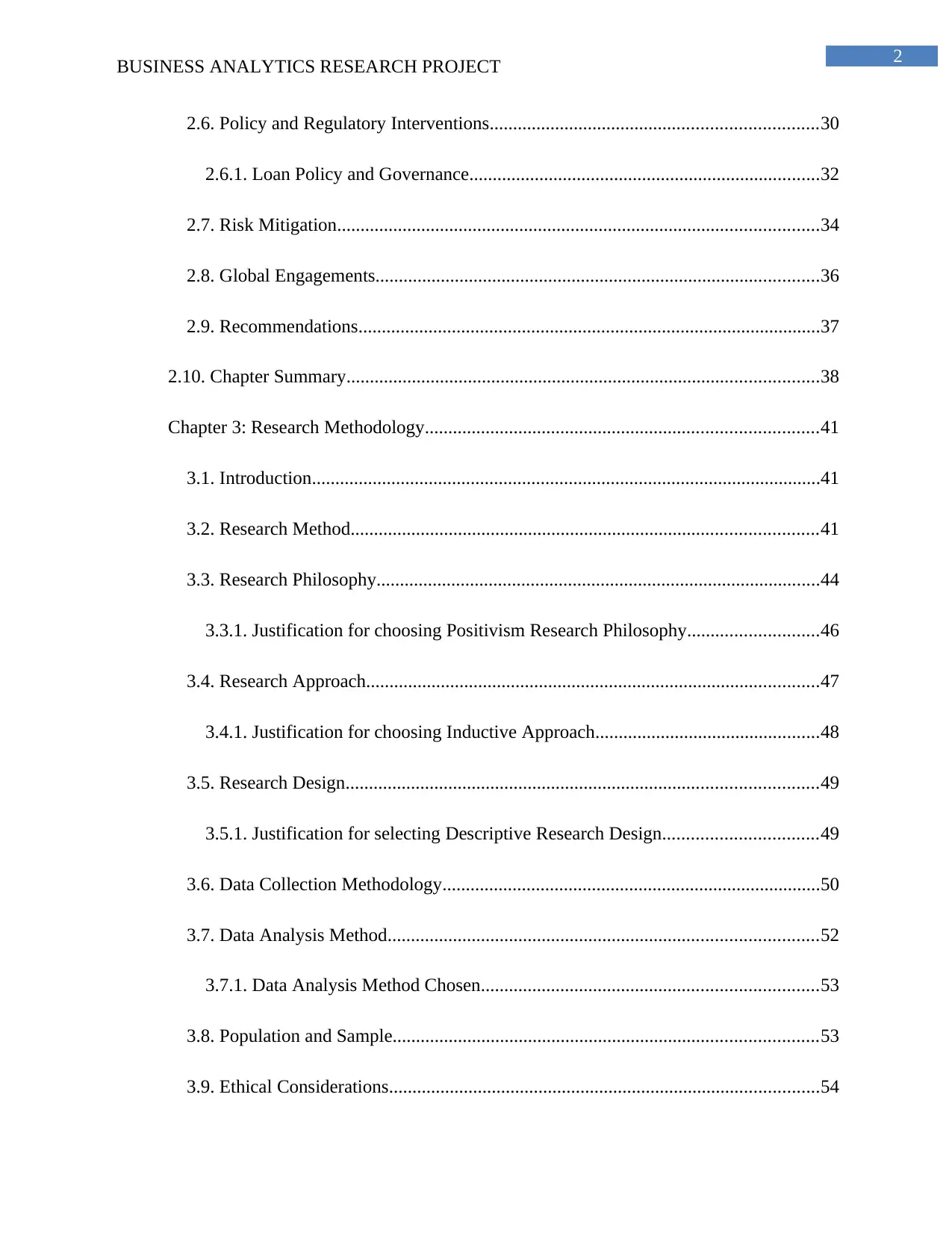
2
BUSINESS ANALYTICS RESEARCH PROJECT
2.6. Policy and Regulatory Interventions......................................................................30
2.6.1. Loan Policy and Governance...........................................................................32
2.7. Risk Mitigation.......................................................................................................34
2.8. Global Engagements...............................................................................................36
2.9. Recommendations...................................................................................................37
2.10. Chapter Summary.....................................................................................................38
Chapter 3: Research Methodology....................................................................................41
3.1. Introduction.............................................................................................................41
3.2. Research Method....................................................................................................41
3.3. Research Philosophy...............................................................................................44
3.3.1. Justification for choosing Positivism Research Philosophy............................46
3.4. Research Approach.................................................................................................47
3.4.1. Justification for choosing Inductive Approach................................................48
3.5. Research Design.....................................................................................................49
3.5.1. Justification for selecting Descriptive Research Design.................................49
3.6. Data Collection Methodology.................................................................................50
3.7. Data Analysis Method............................................................................................52
3.7.1. Data Analysis Method Chosen........................................................................53
3.8. Population and Sample...........................................................................................53
3.9. Ethical Considerations............................................................................................54
BUSINESS ANALYTICS RESEARCH PROJECT
2.6. Policy and Regulatory Interventions......................................................................30
2.6.1. Loan Policy and Governance...........................................................................32
2.7. Risk Mitigation.......................................................................................................34
2.8. Global Engagements...............................................................................................36
2.9. Recommendations...................................................................................................37
2.10. Chapter Summary.....................................................................................................38
Chapter 3: Research Methodology....................................................................................41
3.1. Introduction.............................................................................................................41
3.2. Research Method....................................................................................................41
3.3. Research Philosophy...............................................................................................44
3.3.1. Justification for choosing Positivism Research Philosophy............................46
3.4. Research Approach.................................................................................................47
3.4.1. Justification for choosing Inductive Approach................................................48
3.5. Research Design.....................................................................................................49
3.5.1. Justification for selecting Descriptive Research Design.................................49
3.6. Data Collection Methodology.................................................................................50
3.7. Data Analysis Method............................................................................................52
3.7.1. Data Analysis Method Chosen........................................................................53
3.8. Population and Sample...........................................................................................53
3.9. Ethical Considerations............................................................................................54
⊘ This is a preview!⊘
Do you want full access?
Subscribe today to unlock all pages.

Trusted by 1+ million students worldwide
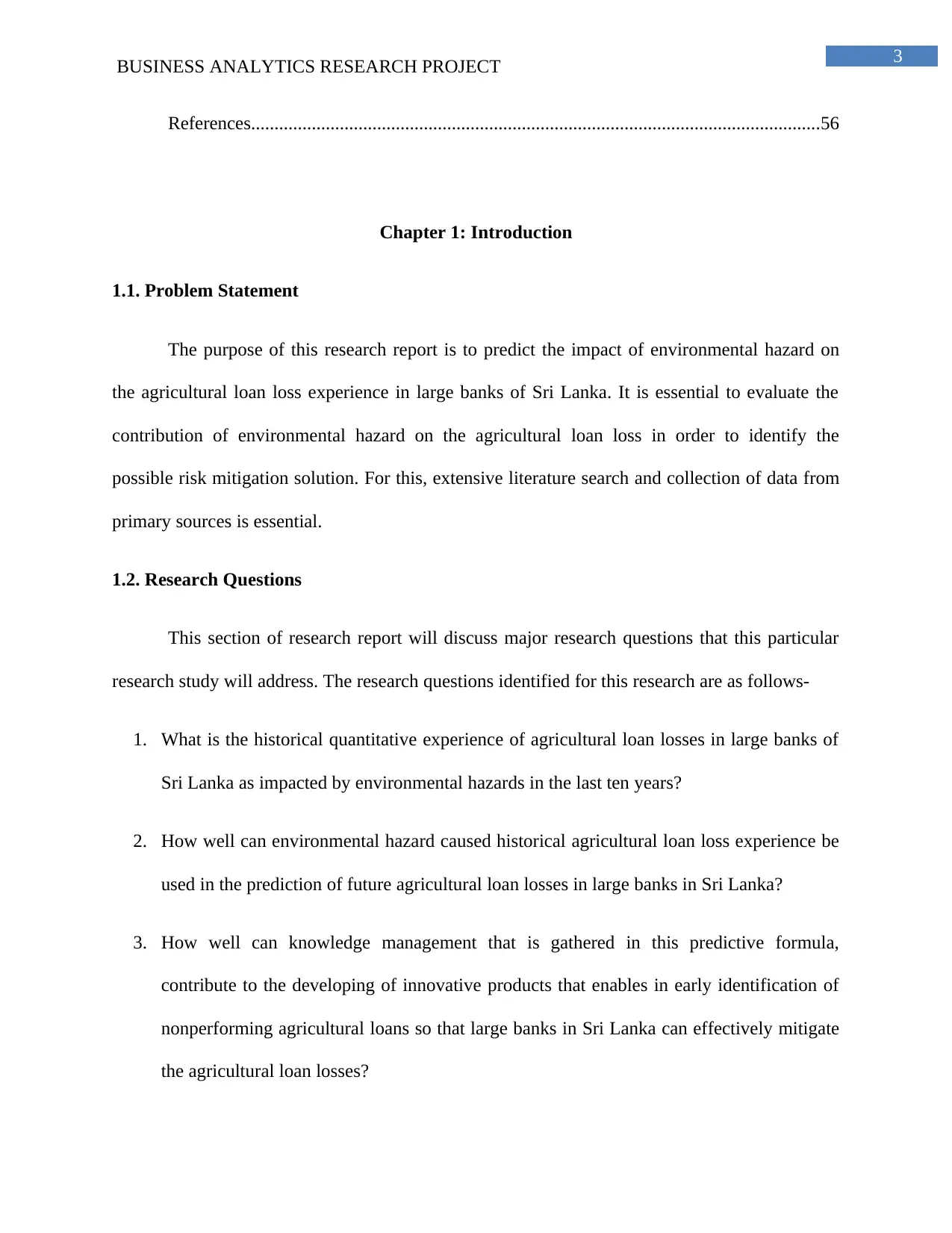
3
BUSINESS ANALYTICS RESEARCH PROJECT
References..........................................................................................................................56
Chapter 1: Introduction
1.1. Problem Statement
The purpose of this research report is to predict the impact of environmental hazard on
the agricultural loan loss experience in large banks of Sri Lanka. It is essential to evaluate the
contribution of environmental hazard on the agricultural loan loss in order to identify the
possible risk mitigation solution. For this, extensive literature search and collection of data from
primary sources is essential.
1.2. Research Questions
This section of research report will discuss major research questions that this particular
research study will address. The research questions identified for this research are as follows-
1. What is the historical quantitative experience of agricultural loan losses in large banks of
Sri Lanka as impacted by environmental hazards in the last ten years?
2. How well can environmental hazard caused historical agricultural loan loss experience be
used in the prediction of future agricultural loan losses in large banks in Sri Lanka?
3. How well can knowledge management that is gathered in this predictive formula,
contribute to the developing of innovative products that enables in early identification of
nonperforming agricultural loans so that large banks in Sri Lanka can effectively mitigate
the agricultural loan losses?
BUSINESS ANALYTICS RESEARCH PROJECT
References..........................................................................................................................56
Chapter 1: Introduction
1.1. Problem Statement
The purpose of this research report is to predict the impact of environmental hazard on
the agricultural loan loss experience in large banks of Sri Lanka. It is essential to evaluate the
contribution of environmental hazard on the agricultural loan loss in order to identify the
possible risk mitigation solution. For this, extensive literature search and collection of data from
primary sources is essential.
1.2. Research Questions
This section of research report will discuss major research questions that this particular
research study will address. The research questions identified for this research are as follows-
1. What is the historical quantitative experience of agricultural loan losses in large banks of
Sri Lanka as impacted by environmental hazards in the last ten years?
2. How well can environmental hazard caused historical agricultural loan loss experience be
used in the prediction of future agricultural loan losses in large banks in Sri Lanka?
3. How well can knowledge management that is gathered in this predictive formula,
contribute to the developing of innovative products that enables in early identification of
nonperforming agricultural loans so that large banks in Sri Lanka can effectively mitigate
the agricultural loan losses?
Paraphrase This Document
Need a fresh take? Get an instant paraphrase of this document with our AI Paraphraser
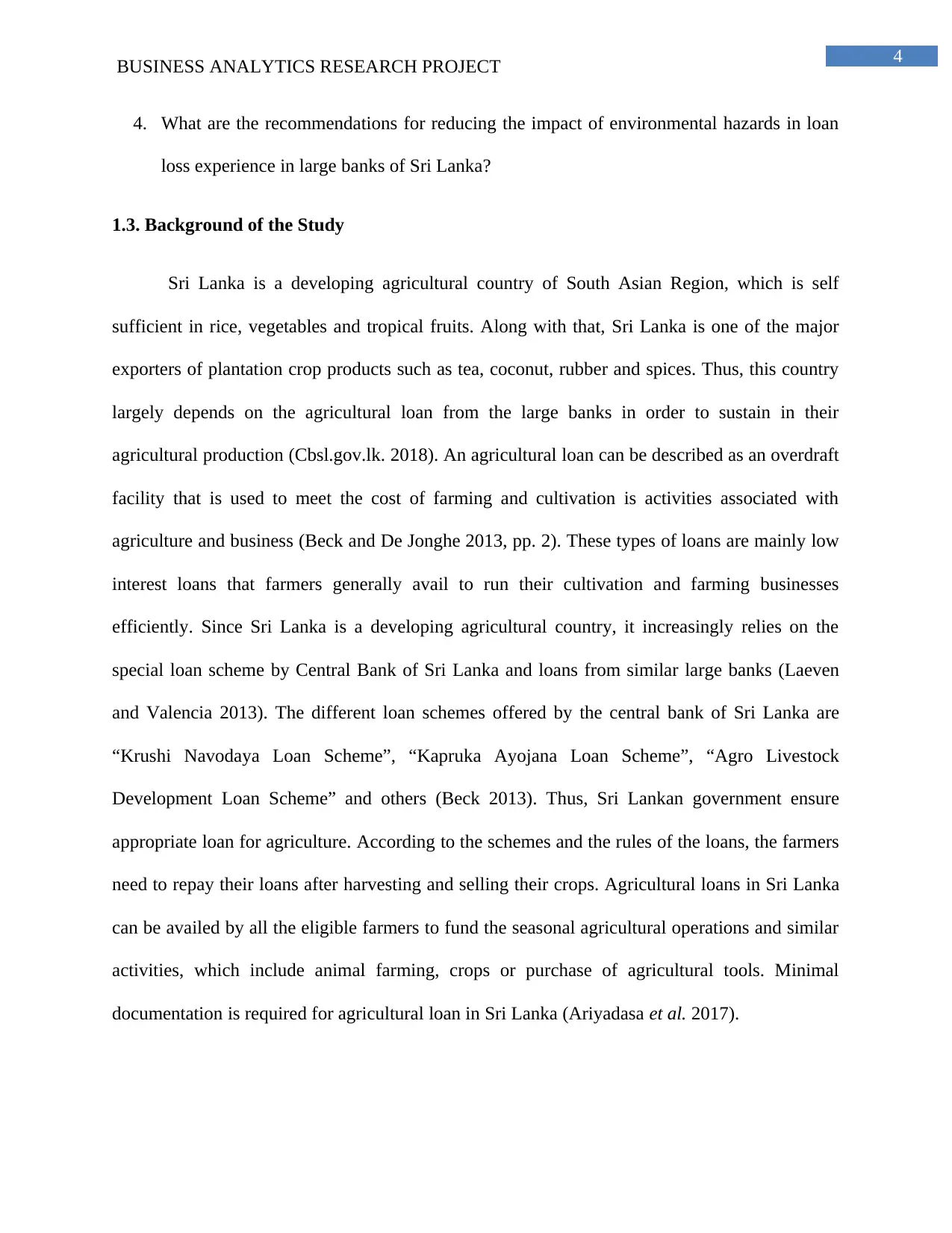
4
BUSINESS ANALYTICS RESEARCH PROJECT
4. What are the recommendations for reducing the impact of environmental hazards in loan
loss experience in large banks of Sri Lanka?
1.3. Background of the Study
Sri Lanka is a developing agricultural country of South Asian Region, which is self
sufficient in rice, vegetables and tropical fruits. Along with that, Sri Lanka is one of the major
exporters of plantation crop products such as tea, coconut, rubber and spices. Thus, this country
largely depends on the agricultural loan from the large banks in order to sustain in their
agricultural production (Cbsl.gov.lk. 2018). An agricultural loan can be described as an overdraft
facility that is used to meet the cost of farming and cultivation is activities associated with
agriculture and business (Beck and De Jonghe 2013, pp. 2). These types of loans are mainly low
interest loans that farmers generally avail to run their cultivation and farming businesses
efficiently. Since Sri Lanka is a developing agricultural country, it increasingly relies on the
special loan scheme by Central Bank of Sri Lanka and loans from similar large banks (Laeven
and Valencia 2013). The different loan schemes offered by the central bank of Sri Lanka are
“Krushi Navodaya Loan Scheme”, “Kapruka Ayojana Loan Scheme”, “Agro Livestock
Development Loan Scheme” and others (Beck 2013). Thus, Sri Lankan government ensure
appropriate loan for agriculture. According to the schemes and the rules of the loans, the farmers
need to repay their loans after harvesting and selling their crops. Agricultural loans in Sri Lanka
can be availed by all the eligible farmers to fund the seasonal agricultural operations and similar
activities, which include animal farming, crops or purchase of agricultural tools. Minimal
documentation is required for agricultural loan in Sri Lanka (Ariyadasa et al. 2017).
BUSINESS ANALYTICS RESEARCH PROJECT
4. What are the recommendations for reducing the impact of environmental hazards in loan
loss experience in large banks of Sri Lanka?
1.3. Background of the Study
Sri Lanka is a developing agricultural country of South Asian Region, which is self
sufficient in rice, vegetables and tropical fruits. Along with that, Sri Lanka is one of the major
exporters of plantation crop products such as tea, coconut, rubber and spices. Thus, this country
largely depends on the agricultural loan from the large banks in order to sustain in their
agricultural production (Cbsl.gov.lk. 2018). An agricultural loan can be described as an overdraft
facility that is used to meet the cost of farming and cultivation is activities associated with
agriculture and business (Beck and De Jonghe 2013, pp. 2). These types of loans are mainly low
interest loans that farmers generally avail to run their cultivation and farming businesses
efficiently. Since Sri Lanka is a developing agricultural country, it increasingly relies on the
special loan scheme by Central Bank of Sri Lanka and loans from similar large banks (Laeven
and Valencia 2013). The different loan schemes offered by the central bank of Sri Lanka are
“Krushi Navodaya Loan Scheme”, “Kapruka Ayojana Loan Scheme”, “Agro Livestock
Development Loan Scheme” and others (Beck 2013). Thus, Sri Lankan government ensure
appropriate loan for agriculture. According to the schemes and the rules of the loans, the farmers
need to repay their loans after harvesting and selling their crops. Agricultural loans in Sri Lanka
can be availed by all the eligible farmers to fund the seasonal agricultural operations and similar
activities, which include animal farming, crops or purchase of agricultural tools. Minimal
documentation is required for agricultural loan in Sri Lanka (Ariyadasa et al. 2017).
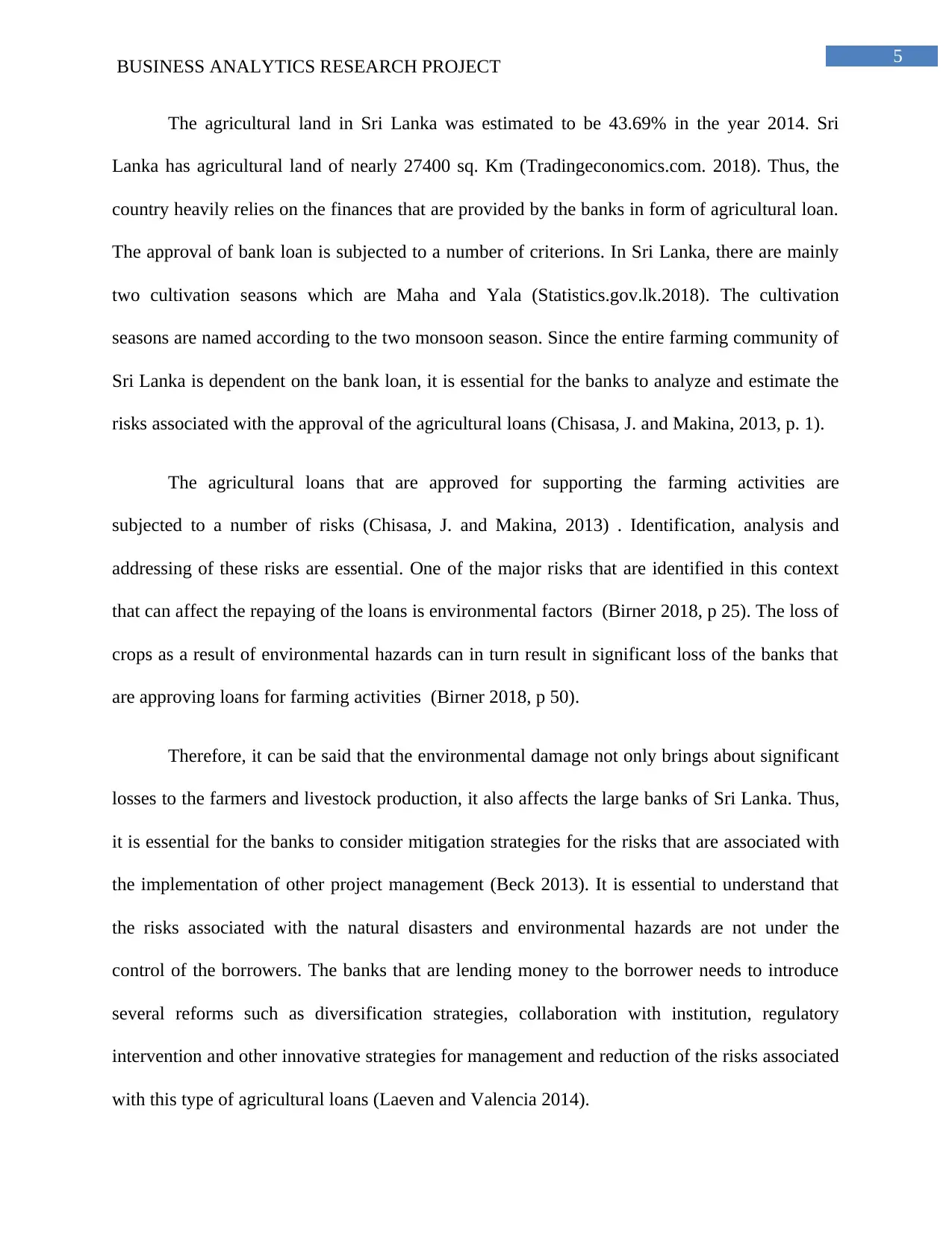
5
BUSINESS ANALYTICS RESEARCH PROJECT
The agricultural land in Sri Lanka was estimated to be 43.69% in the year 2014. Sri
Lanka has agricultural land of nearly 27400 sq. Km (Tradingeconomics.com. 2018). Thus, the
country heavily relies on the finances that are provided by the banks in form of agricultural loan.
The approval of bank loan is subjected to a number of criterions. In Sri Lanka, there are mainly
two cultivation seasons which are Maha and Yala (Statistics.gov.lk.2018). The cultivation
seasons are named according to the two monsoon season. Since the entire farming community of
Sri Lanka is dependent on the bank loan, it is essential for the banks to analyze and estimate the
risks associated with the approval of the agricultural loans (Chisasa, J. and Makina, 2013, p. 1).
The agricultural loans that are approved for supporting the farming activities are
subjected to a number of risks (Chisasa, J. and Makina, 2013) . Identification, analysis and
addressing of these risks are essential. One of the major risks that are identified in this context
that can affect the repaying of the loans is environmental factors (Birner 2018, p 25). The loss of
crops as a result of environmental hazards can in turn result in significant loss of the banks that
are approving loans for farming activities (Birner 2018, p 50).
Therefore, it can be said that the environmental damage not only brings about significant
losses to the farmers and livestock production, it also affects the large banks of Sri Lanka. Thus,
it is essential for the banks to consider mitigation strategies for the risks that are associated with
the implementation of other project management (Beck 2013). It is essential to understand that
the risks associated with the natural disasters and environmental hazards are not under the
control of the borrowers. The banks that are lending money to the borrower needs to introduce
several reforms such as diversification strategies, collaboration with institution, regulatory
intervention and other innovative strategies for management and reduction of the risks associated
with this type of agricultural loans (Laeven and Valencia 2014).
BUSINESS ANALYTICS RESEARCH PROJECT
The agricultural land in Sri Lanka was estimated to be 43.69% in the year 2014. Sri
Lanka has agricultural land of nearly 27400 sq. Km (Tradingeconomics.com. 2018). Thus, the
country heavily relies on the finances that are provided by the banks in form of agricultural loan.
The approval of bank loan is subjected to a number of criterions. In Sri Lanka, there are mainly
two cultivation seasons which are Maha and Yala (Statistics.gov.lk.2018). The cultivation
seasons are named according to the two monsoon season. Since the entire farming community of
Sri Lanka is dependent on the bank loan, it is essential for the banks to analyze and estimate the
risks associated with the approval of the agricultural loans (Chisasa, J. and Makina, 2013, p. 1).
The agricultural loans that are approved for supporting the farming activities are
subjected to a number of risks (Chisasa, J. and Makina, 2013) . Identification, analysis and
addressing of these risks are essential. One of the major risks that are identified in this context
that can affect the repaying of the loans is environmental factors (Birner 2018, p 25). The loss of
crops as a result of environmental hazards can in turn result in significant loss of the banks that
are approving loans for farming activities (Birner 2018, p 50).
Therefore, it can be said that the environmental damage not only brings about significant
losses to the farmers and livestock production, it also affects the large banks of Sri Lanka. Thus,
it is essential for the banks to consider mitigation strategies for the risks that are associated with
the implementation of other project management (Beck 2013). It is essential to understand that
the risks associated with the natural disasters and environmental hazards are not under the
control of the borrowers. The banks that are lending money to the borrower needs to introduce
several reforms such as diversification strategies, collaboration with institution, regulatory
intervention and other innovative strategies for management and reduction of the risks associated
with this type of agricultural loans (Laeven and Valencia 2014).
⊘ This is a preview!⊘
Do you want full access?
Subscribe today to unlock all pages.

Trusted by 1+ million students worldwide
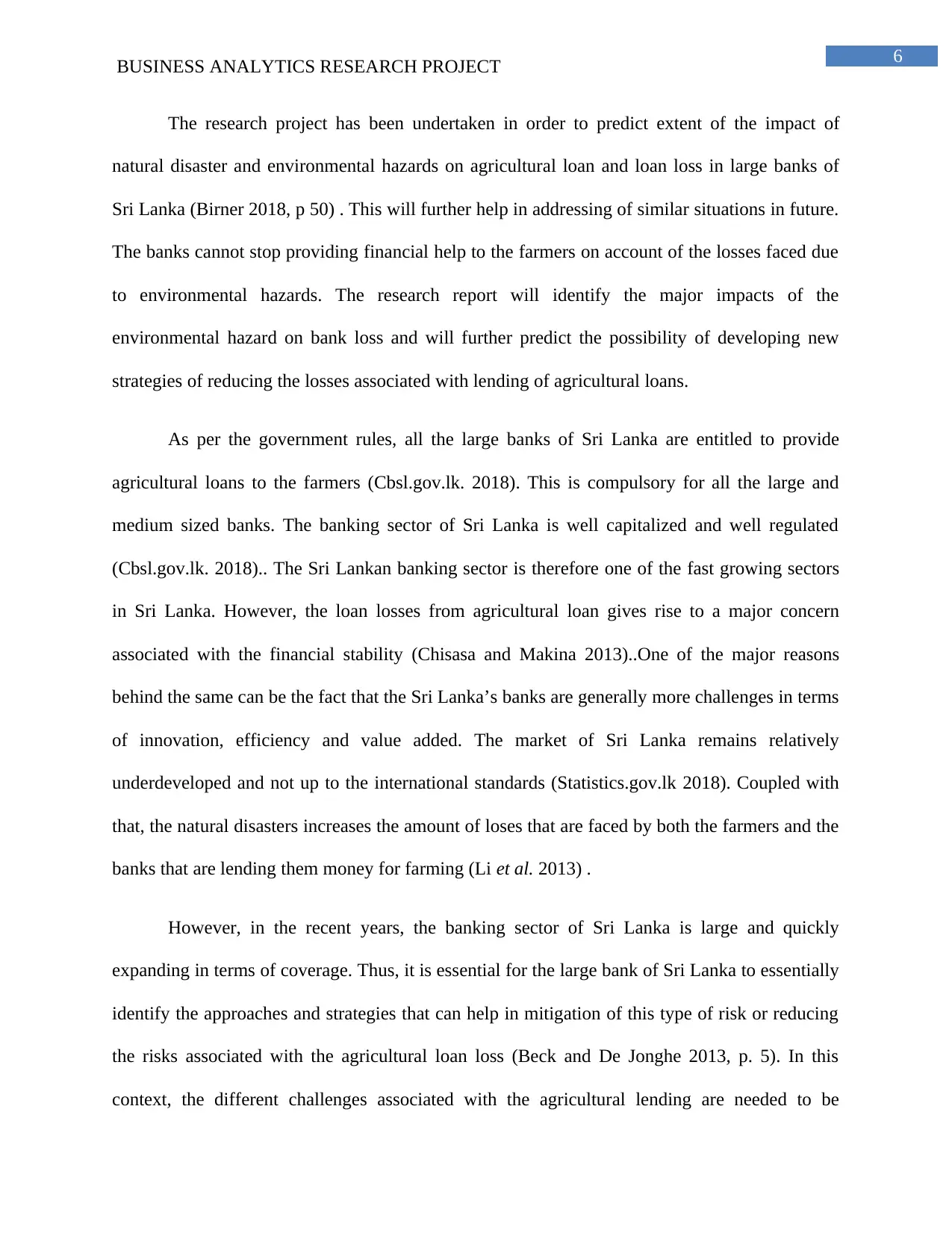
6
BUSINESS ANALYTICS RESEARCH PROJECT
The research project has been undertaken in order to predict extent of the impact of
natural disaster and environmental hazards on agricultural loan and loan loss in large banks of
Sri Lanka (Birner 2018, p 50) . This will further help in addressing of similar situations in future.
The banks cannot stop providing financial help to the farmers on account of the losses faced due
to environmental hazards. The research report will identify the major impacts of the
environmental hazard on bank loss and will further predict the possibility of developing new
strategies of reducing the losses associated with lending of agricultural loans.
As per the government rules, all the large banks of Sri Lanka are entitled to provide
agricultural loans to the farmers (Cbsl.gov.lk. 2018). This is compulsory for all the large and
medium sized banks. The banking sector of Sri Lanka is well capitalized and well regulated
(Cbsl.gov.lk. 2018).. The Sri Lankan banking sector is therefore one of the fast growing sectors
in Sri Lanka. However, the loan losses from agricultural loan gives rise to a major concern
associated with the financial stability (Chisasa and Makina 2013)..One of the major reasons
behind the same can be the fact that the Sri Lanka’s banks are generally more challenges in terms
of innovation, efficiency and value added. The market of Sri Lanka remains relatively
underdeveloped and not up to the international standards (Statistics.gov.lk 2018). Coupled with
that, the natural disasters increases the amount of loses that are faced by both the farmers and the
banks that are lending them money for farming (Li et al. 2013) .
However, in the recent years, the banking sector of Sri Lanka is large and quickly
expanding in terms of coverage. Thus, it is essential for the large bank of Sri Lanka to essentially
identify the approaches and strategies that can help in mitigation of this type of risk or reducing
the risks associated with the agricultural loan loss (Beck and De Jonghe 2013, p. 5). In this
context, the different challenges associated with the agricultural lending are needed to be
BUSINESS ANALYTICS RESEARCH PROJECT
The research project has been undertaken in order to predict extent of the impact of
natural disaster and environmental hazards on agricultural loan and loan loss in large banks of
Sri Lanka (Birner 2018, p 50) . This will further help in addressing of similar situations in future.
The banks cannot stop providing financial help to the farmers on account of the losses faced due
to environmental hazards. The research report will identify the major impacts of the
environmental hazard on bank loss and will further predict the possibility of developing new
strategies of reducing the losses associated with lending of agricultural loans.
As per the government rules, all the large banks of Sri Lanka are entitled to provide
agricultural loans to the farmers (Cbsl.gov.lk. 2018). This is compulsory for all the large and
medium sized banks. The banking sector of Sri Lanka is well capitalized and well regulated
(Cbsl.gov.lk. 2018).. The Sri Lankan banking sector is therefore one of the fast growing sectors
in Sri Lanka. However, the loan losses from agricultural loan gives rise to a major concern
associated with the financial stability (Chisasa and Makina 2013)..One of the major reasons
behind the same can be the fact that the Sri Lanka’s banks are generally more challenges in terms
of innovation, efficiency and value added. The market of Sri Lanka remains relatively
underdeveloped and not up to the international standards (Statistics.gov.lk 2018). Coupled with
that, the natural disasters increases the amount of loses that are faced by both the farmers and the
banks that are lending them money for farming (Li et al. 2013) .
However, in the recent years, the banking sector of Sri Lanka is large and quickly
expanding in terms of coverage. Thus, it is essential for the large bank of Sri Lanka to essentially
identify the approaches and strategies that can help in mitigation of this type of risk or reducing
the risks associated with the agricultural loan loss (Beck and De Jonghe 2013, p. 5). In this
context, the different challenges associated with the agricultural lending are needed to be
Paraphrase This Document
Need a fresh take? Get an instant paraphrase of this document with our AI Paraphraser
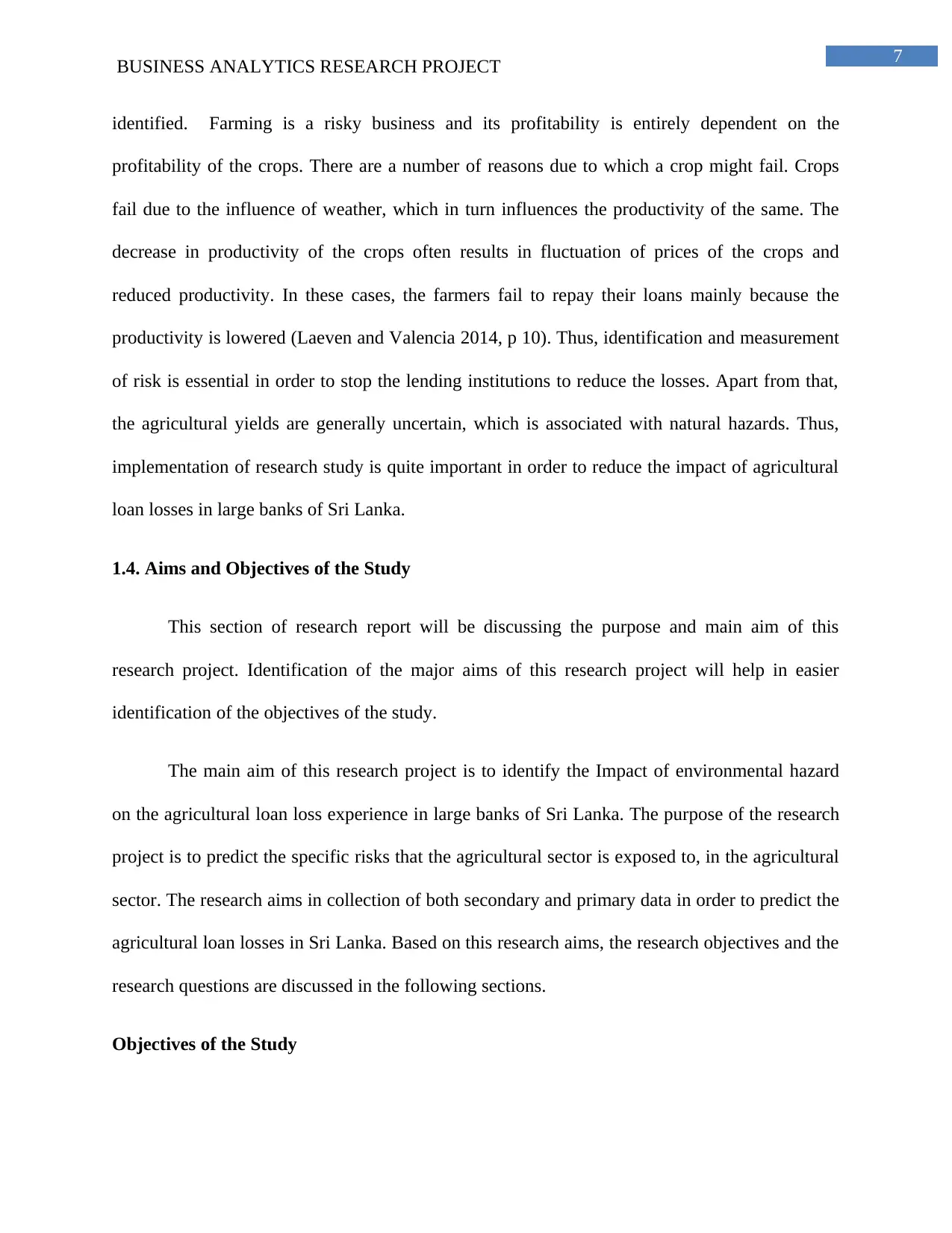
7
BUSINESS ANALYTICS RESEARCH PROJECT
identified. Farming is a risky business and its profitability is entirely dependent on the
profitability of the crops. There are a number of reasons due to which a crop might fail. Crops
fail due to the influence of weather, which in turn influences the productivity of the same. The
decrease in productivity of the crops often results in fluctuation of prices of the crops and
reduced productivity. In these cases, the farmers fail to repay their loans mainly because the
productivity is lowered (Laeven and Valencia 2014, p 10). Thus, identification and measurement
of risk is essential in order to stop the lending institutions to reduce the losses. Apart from that,
the agricultural yields are generally uncertain, which is associated with natural hazards. Thus,
implementation of research study is quite important in order to reduce the impact of agricultural
loan losses in large banks of Sri Lanka.
1.4. Aims and Objectives of the Study
This section of research report will be discussing the purpose and main aim of this
research project. Identification of the major aims of this research project will help in easier
identification of the objectives of the study.
The main aim of this research project is to identify the Impact of environmental hazard
on the agricultural loan loss experience in large banks of Sri Lanka. The purpose of the research
project is to predict the specific risks that the agricultural sector is exposed to, in the agricultural
sector. The research aims in collection of both secondary and primary data in order to predict the
agricultural loan losses in Sri Lanka. Based on this research aims, the research objectives and the
research questions are discussed in the following sections.
Objectives of the Study
BUSINESS ANALYTICS RESEARCH PROJECT
identified. Farming is a risky business and its profitability is entirely dependent on the
profitability of the crops. There are a number of reasons due to which a crop might fail. Crops
fail due to the influence of weather, which in turn influences the productivity of the same. The
decrease in productivity of the crops often results in fluctuation of prices of the crops and
reduced productivity. In these cases, the farmers fail to repay their loans mainly because the
productivity is lowered (Laeven and Valencia 2014, p 10). Thus, identification and measurement
of risk is essential in order to stop the lending institutions to reduce the losses. Apart from that,
the agricultural yields are generally uncertain, which is associated with natural hazards. Thus,
implementation of research study is quite important in order to reduce the impact of agricultural
loan losses in large banks of Sri Lanka.
1.4. Aims and Objectives of the Study
This section of research report will be discussing the purpose and main aim of this
research project. Identification of the major aims of this research project will help in easier
identification of the objectives of the study.
The main aim of this research project is to identify the Impact of environmental hazard
on the agricultural loan loss experience in large banks of Sri Lanka. The purpose of the research
project is to predict the specific risks that the agricultural sector is exposed to, in the agricultural
sector. The research aims in collection of both secondary and primary data in order to predict the
agricultural loan losses in Sri Lanka. Based on this research aims, the research objectives and the
research questions are discussed in the following sections.
Objectives of the Study
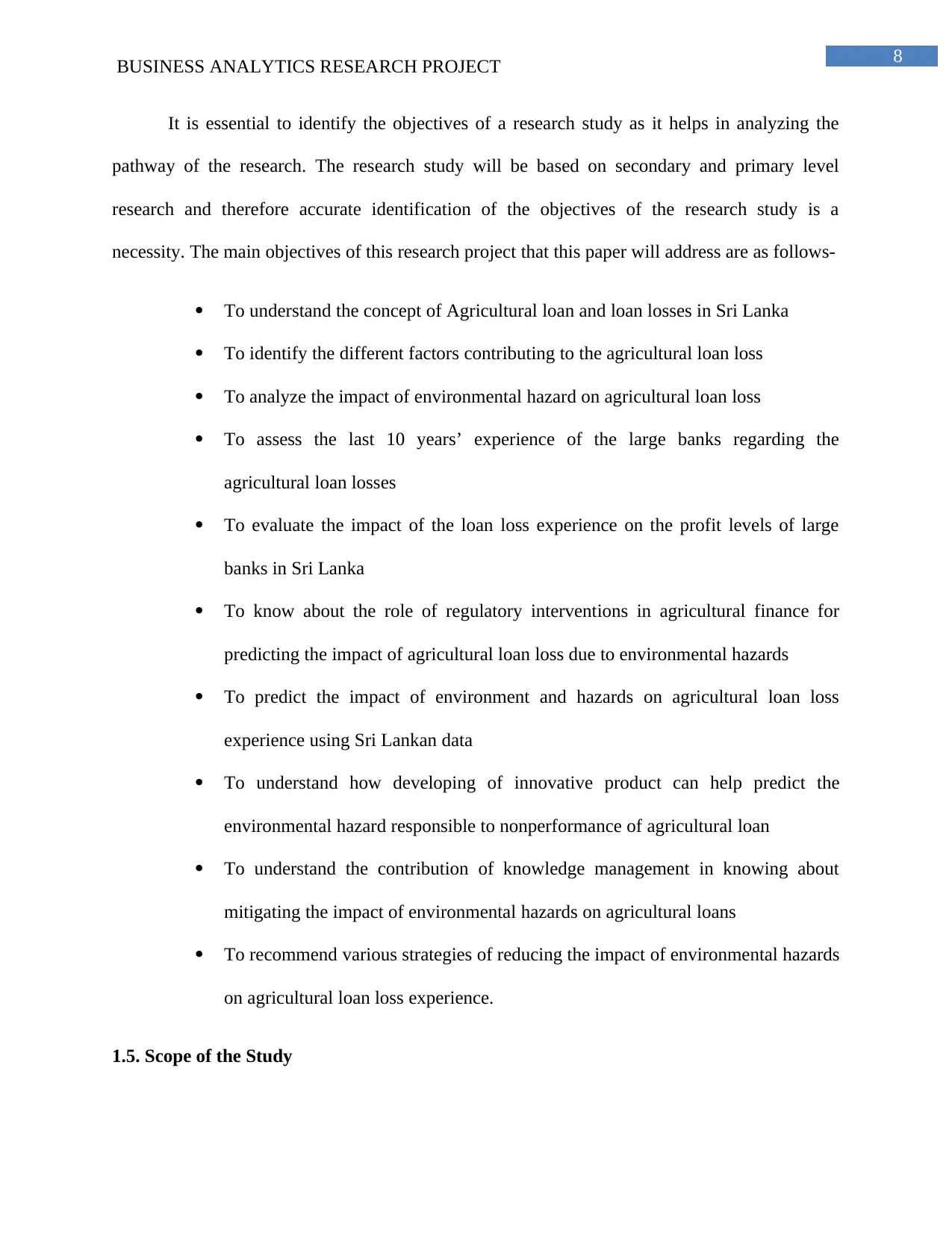
8
BUSINESS ANALYTICS RESEARCH PROJECT
It is essential to identify the objectives of a research study as it helps in analyzing the
pathway of the research. The research study will be based on secondary and primary level
research and therefore accurate identification of the objectives of the research study is a
necessity. The main objectives of this research project that this paper will address are as follows-
To understand the concept of Agricultural loan and loan losses in Sri Lanka
To identify the different factors contributing to the agricultural loan loss
To analyze the impact of environmental hazard on agricultural loan loss
To assess the last 10 years’ experience of the large banks regarding the
agricultural loan losses
To evaluate the impact of the loan loss experience on the profit levels of large
banks in Sri Lanka
To know about the role of regulatory interventions in agricultural finance for
predicting the impact of agricultural loan loss due to environmental hazards
To predict the impact of environment and hazards on agricultural loan loss
experience using Sri Lankan data
To understand how developing of innovative product can help predict the
environmental hazard responsible to nonperformance of agricultural loan
To understand the contribution of knowledge management in knowing about
mitigating the impact of environmental hazards on agricultural loans
To recommend various strategies of reducing the impact of environmental hazards
on agricultural loan loss experience.
1.5. Scope of the Study
BUSINESS ANALYTICS RESEARCH PROJECT
It is essential to identify the objectives of a research study as it helps in analyzing the
pathway of the research. The research study will be based on secondary and primary level
research and therefore accurate identification of the objectives of the research study is a
necessity. The main objectives of this research project that this paper will address are as follows-
To understand the concept of Agricultural loan and loan losses in Sri Lanka
To identify the different factors contributing to the agricultural loan loss
To analyze the impact of environmental hazard on agricultural loan loss
To assess the last 10 years’ experience of the large banks regarding the
agricultural loan losses
To evaluate the impact of the loan loss experience on the profit levels of large
banks in Sri Lanka
To know about the role of regulatory interventions in agricultural finance for
predicting the impact of agricultural loan loss due to environmental hazards
To predict the impact of environment and hazards on agricultural loan loss
experience using Sri Lankan data
To understand how developing of innovative product can help predict the
environmental hazard responsible to nonperformance of agricultural loan
To understand the contribution of knowledge management in knowing about
mitigating the impact of environmental hazards on agricultural loans
To recommend various strategies of reducing the impact of environmental hazards
on agricultural loan loss experience.
1.5. Scope of the Study
⊘ This is a preview!⊘
Do you want full access?
Subscribe today to unlock all pages.

Trusted by 1+ million students worldwide
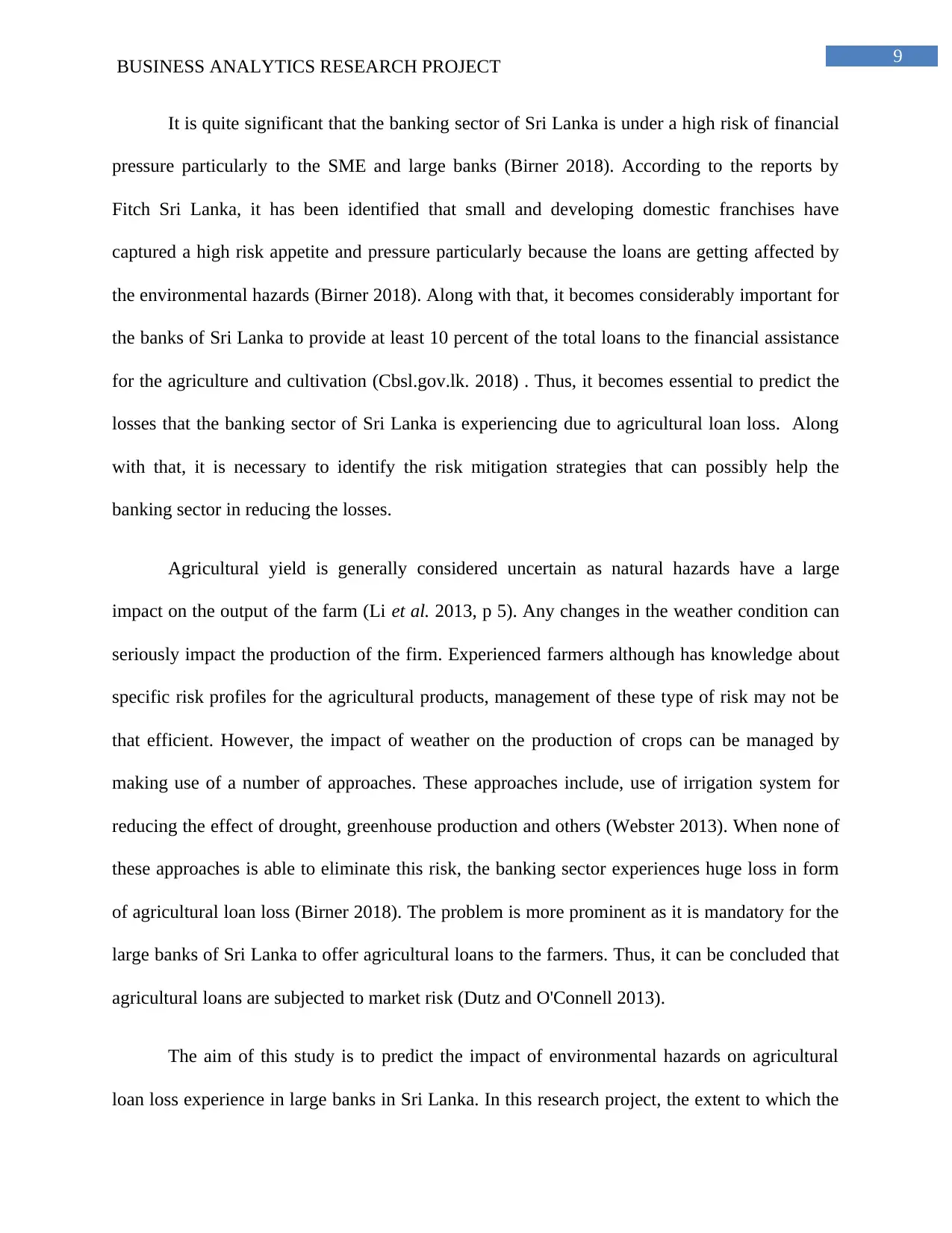
9
BUSINESS ANALYTICS RESEARCH PROJECT
It is quite significant that the banking sector of Sri Lanka is under a high risk of financial
pressure particularly to the SME and large banks (Birner 2018). According to the reports by
Fitch Sri Lanka, it has been identified that small and developing domestic franchises have
captured a high risk appetite and pressure particularly because the loans are getting affected by
the environmental hazards (Birner 2018). Along with that, it becomes considerably important for
the banks of Sri Lanka to provide at least 10 percent of the total loans to the financial assistance
for the agriculture and cultivation (Cbsl.gov.lk. 2018) . Thus, it becomes essential to predict the
losses that the banking sector of Sri Lanka is experiencing due to agricultural loan loss. Along
with that, it is necessary to identify the risk mitigation strategies that can possibly help the
banking sector in reducing the losses.
Agricultural yield is generally considered uncertain as natural hazards have a large
impact on the output of the farm (Li et al. 2013, p 5). Any changes in the weather condition can
seriously impact the production of the firm. Experienced farmers although has knowledge about
specific risk profiles for the agricultural products, management of these type of risk may not be
that efficient. However, the impact of weather on the production of crops can be managed by
making use of a number of approaches. These approaches include, use of irrigation system for
reducing the effect of drought, greenhouse production and others (Webster 2013). When none of
these approaches is able to eliminate this risk, the banking sector experiences huge loss in form
of agricultural loan loss (Birner 2018). The problem is more prominent as it is mandatory for the
large banks of Sri Lanka to offer agricultural loans to the farmers. Thus, it can be concluded that
agricultural loans are subjected to market risk (Dutz and O'Connell 2013).
The aim of this study is to predict the impact of environmental hazards on agricultural
loan loss experience in large banks in Sri Lanka. In this research project, the extent to which the
BUSINESS ANALYTICS RESEARCH PROJECT
It is quite significant that the banking sector of Sri Lanka is under a high risk of financial
pressure particularly to the SME and large banks (Birner 2018). According to the reports by
Fitch Sri Lanka, it has been identified that small and developing domestic franchises have
captured a high risk appetite and pressure particularly because the loans are getting affected by
the environmental hazards (Birner 2018). Along with that, it becomes considerably important for
the banks of Sri Lanka to provide at least 10 percent of the total loans to the financial assistance
for the agriculture and cultivation (Cbsl.gov.lk. 2018) . Thus, it becomes essential to predict the
losses that the banking sector of Sri Lanka is experiencing due to agricultural loan loss. Along
with that, it is necessary to identify the risk mitigation strategies that can possibly help the
banking sector in reducing the losses.
Agricultural yield is generally considered uncertain as natural hazards have a large
impact on the output of the farm (Li et al. 2013, p 5). Any changes in the weather condition can
seriously impact the production of the firm. Experienced farmers although has knowledge about
specific risk profiles for the agricultural products, management of these type of risk may not be
that efficient. However, the impact of weather on the production of crops can be managed by
making use of a number of approaches. These approaches include, use of irrigation system for
reducing the effect of drought, greenhouse production and others (Webster 2013). When none of
these approaches is able to eliminate this risk, the banking sector experiences huge loss in form
of agricultural loan loss (Birner 2018). The problem is more prominent as it is mandatory for the
large banks of Sri Lanka to offer agricultural loans to the farmers. Thus, it can be concluded that
agricultural loans are subjected to market risk (Dutz and O'Connell 2013).
The aim of this study is to predict the impact of environmental hazards on agricultural
loan loss experience in large banks in Sri Lanka. In this research project, the extent to which the
Paraphrase This Document
Need a fresh take? Get an instant paraphrase of this document with our AI Paraphraser
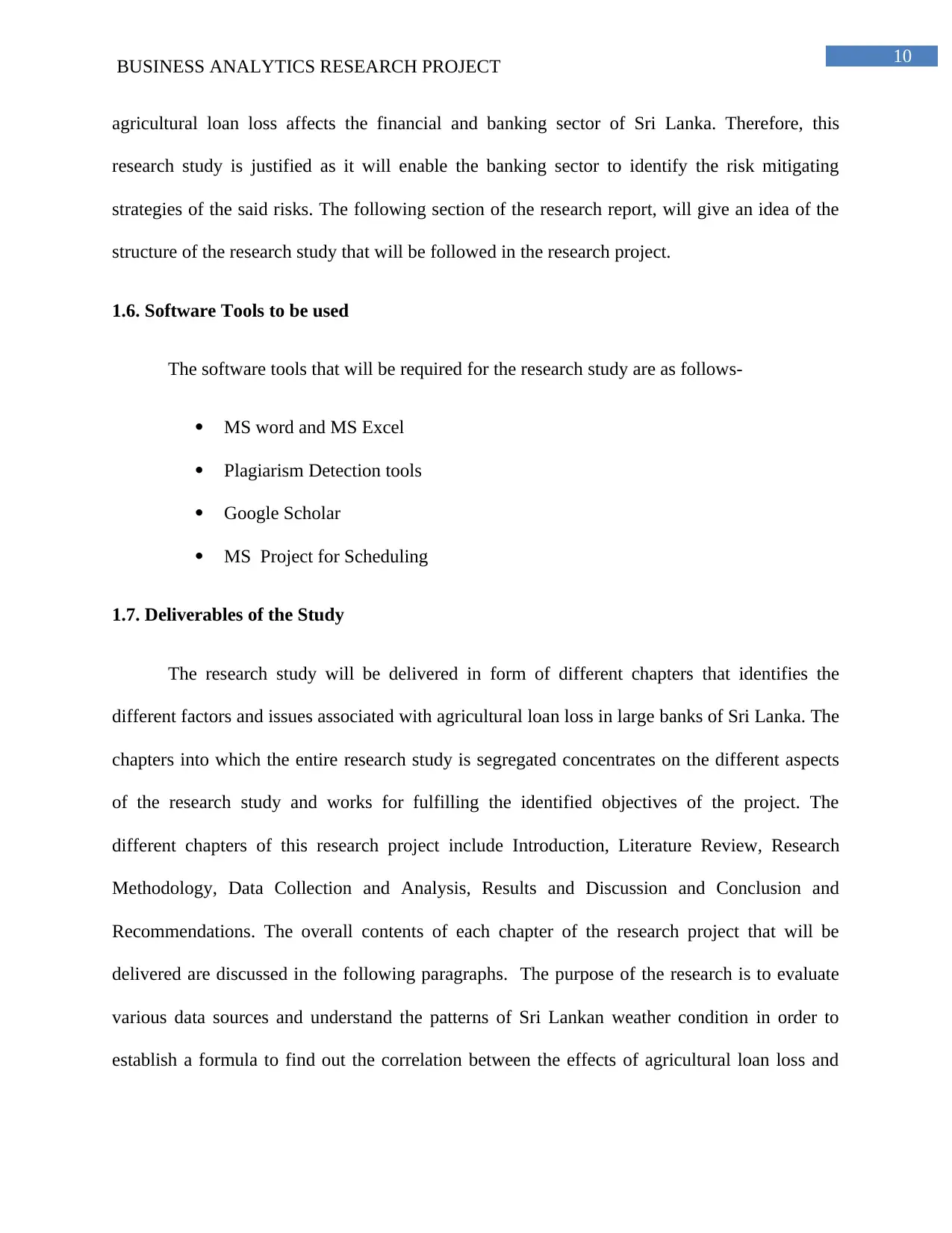
10
BUSINESS ANALYTICS RESEARCH PROJECT
agricultural loan loss affects the financial and banking sector of Sri Lanka. Therefore, this
research study is justified as it will enable the banking sector to identify the risk mitigating
strategies of the said risks. The following section of the research report, will give an idea of the
structure of the research study that will be followed in the research project.
1.6. Software Tools to be used
The software tools that will be required for the research study are as follows-
MS word and MS Excel
Plagiarism Detection tools
Google Scholar
MS Project for Scheduling
1.7. Deliverables of the Study
The research study will be delivered in form of different chapters that identifies the
different factors and issues associated with agricultural loan loss in large banks of Sri Lanka. The
chapters into which the entire research study is segregated concentrates on the different aspects
of the research study and works for fulfilling the identified objectives of the project. The
different chapters of this research project include Introduction, Literature Review, Research
Methodology, Data Collection and Analysis, Results and Discussion and Conclusion and
Recommendations. The overall contents of each chapter of the research project that will be
delivered are discussed in the following paragraphs. The purpose of the research is to evaluate
various data sources and understand the patterns of Sri Lankan weather condition in order to
establish a formula to find out the correlation between the effects of agricultural loan loss and
BUSINESS ANALYTICS RESEARCH PROJECT
agricultural loan loss affects the financial and banking sector of Sri Lanka. Therefore, this
research study is justified as it will enable the banking sector to identify the risk mitigating
strategies of the said risks. The following section of the research report, will give an idea of the
structure of the research study that will be followed in the research project.
1.6. Software Tools to be used
The software tools that will be required for the research study are as follows-
MS word and MS Excel
Plagiarism Detection tools
Google Scholar
MS Project for Scheduling
1.7. Deliverables of the Study
The research study will be delivered in form of different chapters that identifies the
different factors and issues associated with agricultural loan loss in large banks of Sri Lanka. The
chapters into which the entire research study is segregated concentrates on the different aspects
of the research study and works for fulfilling the identified objectives of the project. The
different chapters of this research project include Introduction, Literature Review, Research
Methodology, Data Collection and Analysis, Results and Discussion and Conclusion and
Recommendations. The overall contents of each chapter of the research project that will be
delivered are discussed in the following paragraphs. The purpose of the research is to evaluate
various data sources and understand the patterns of Sri Lankan weather condition in order to
establish a formula to find out the correlation between the effects of agricultural loan loss and
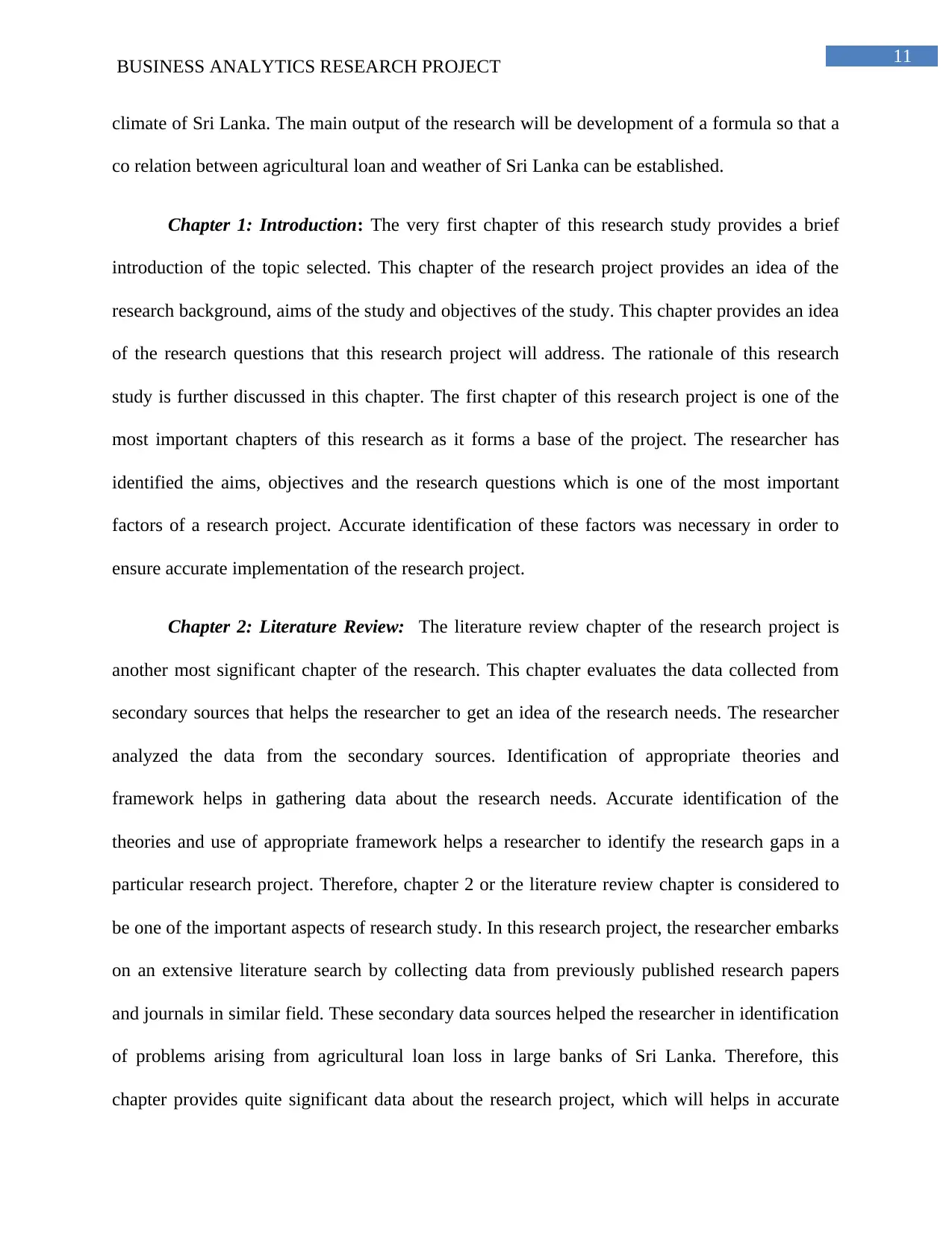
11
BUSINESS ANALYTICS RESEARCH PROJECT
climate of Sri Lanka. The main output of the research will be development of a formula so that a
co relation between agricultural loan and weather of Sri Lanka can be established.
Chapter 1: Introduction: The very first chapter of this research study provides a brief
introduction of the topic selected. This chapter of the research project provides an idea of the
research background, aims of the study and objectives of the study. This chapter provides an idea
of the research questions that this research project will address. The rationale of this research
study is further discussed in this chapter. The first chapter of this research project is one of the
most important chapters of this research as it forms a base of the project. The researcher has
identified the aims, objectives and the research questions which is one of the most important
factors of a research project. Accurate identification of these factors was necessary in order to
ensure accurate implementation of the research project.
Chapter 2: Literature Review: The literature review chapter of the research project is
another most significant chapter of the research. This chapter evaluates the data collected from
secondary sources that helps the researcher to get an idea of the research needs. The researcher
analyzed the data from the secondary sources. Identification of appropriate theories and
framework helps in gathering data about the research needs. Accurate identification of the
theories and use of appropriate framework helps a researcher to identify the research gaps in a
particular research project. Therefore, chapter 2 or the literature review chapter is considered to
be one of the important aspects of research study. In this research project, the researcher embarks
on an extensive literature search by collecting data from previously published research papers
and journals in similar field. These secondary data sources helped the researcher in identification
of problems arising from agricultural loan loss in large banks of Sri Lanka. Therefore, this
chapter provides quite significant data about the research project, which will helps in accurate
BUSINESS ANALYTICS RESEARCH PROJECT
climate of Sri Lanka. The main output of the research will be development of a formula so that a
co relation between agricultural loan and weather of Sri Lanka can be established.
Chapter 1: Introduction: The very first chapter of this research study provides a brief
introduction of the topic selected. This chapter of the research project provides an idea of the
research background, aims of the study and objectives of the study. This chapter provides an idea
of the research questions that this research project will address. The rationale of this research
study is further discussed in this chapter. The first chapter of this research project is one of the
most important chapters of this research as it forms a base of the project. The researcher has
identified the aims, objectives and the research questions which is one of the most important
factors of a research project. Accurate identification of these factors was necessary in order to
ensure accurate implementation of the research project.
Chapter 2: Literature Review: The literature review chapter of the research project is
another most significant chapter of the research. This chapter evaluates the data collected from
secondary sources that helps the researcher to get an idea of the research needs. The researcher
analyzed the data from the secondary sources. Identification of appropriate theories and
framework helps in gathering data about the research needs. Accurate identification of the
theories and use of appropriate framework helps a researcher to identify the research gaps in a
particular research project. Therefore, chapter 2 or the literature review chapter is considered to
be one of the important aspects of research study. In this research project, the researcher embarks
on an extensive literature search by collecting data from previously published research papers
and journals in similar field. These secondary data sources helped the researcher in identification
of problems arising from agricultural loan loss in large banks of Sri Lanka. Therefore, this
chapter provides quite significant data about the research project, which will helps in accurate
⊘ This is a preview!⊘
Do you want full access?
Subscribe today to unlock all pages.

Trusted by 1+ million students worldwide
1 out of 63
Related Documents
Your All-in-One AI-Powered Toolkit for Academic Success.
+13062052269
info@desklib.com
Available 24*7 on WhatsApp / Email
![[object Object]](/_next/static/media/star-bottom.7253800d.svg)
Unlock your academic potential
Copyright © 2020–2025 A2Z Services. All Rights Reserved. Developed and managed by ZUCOL.



